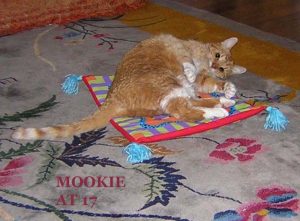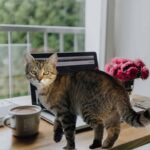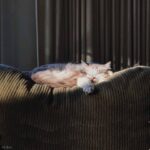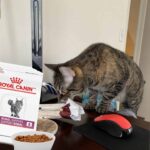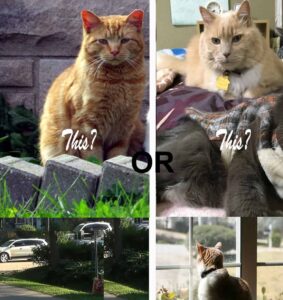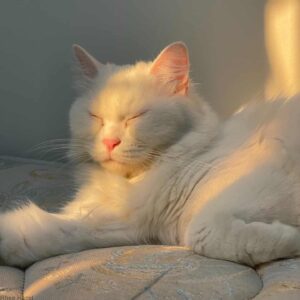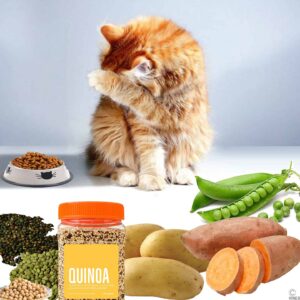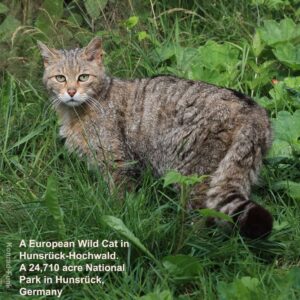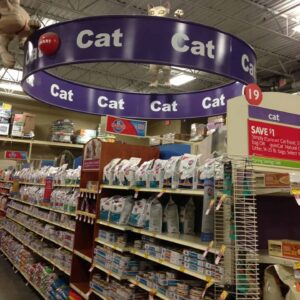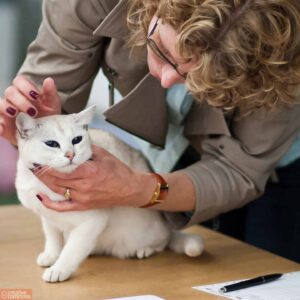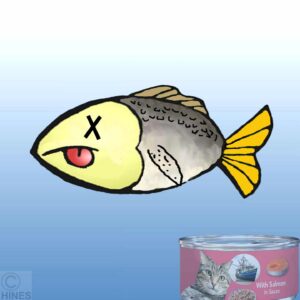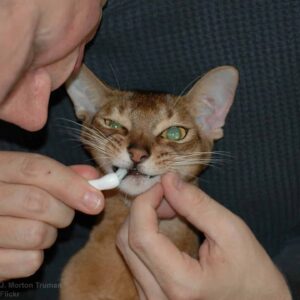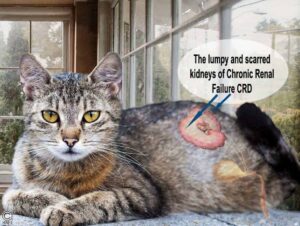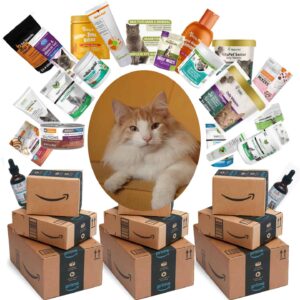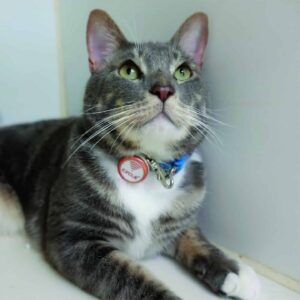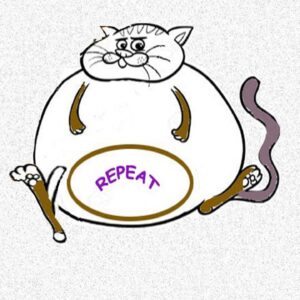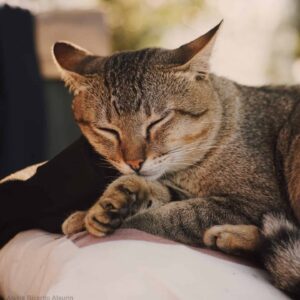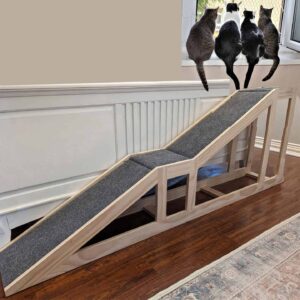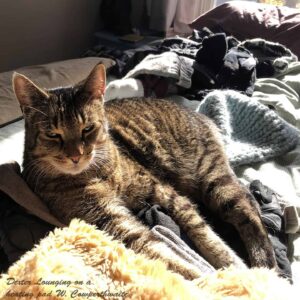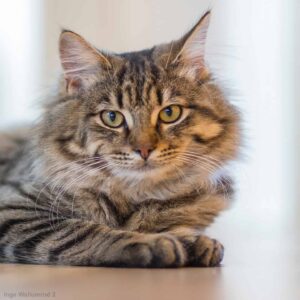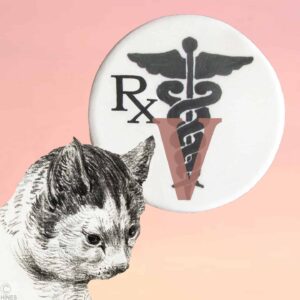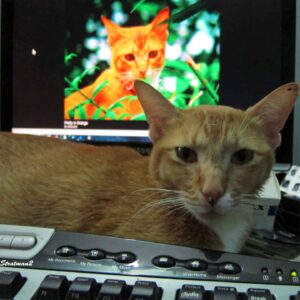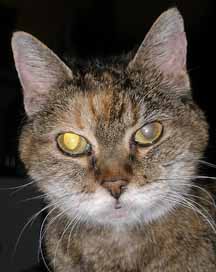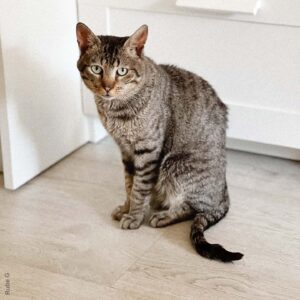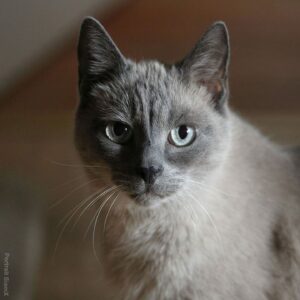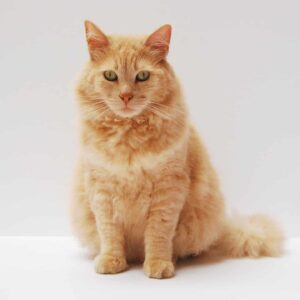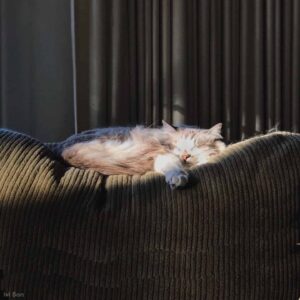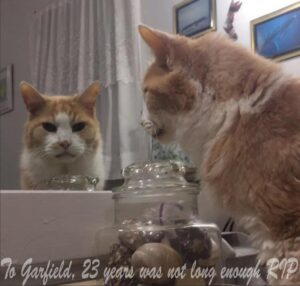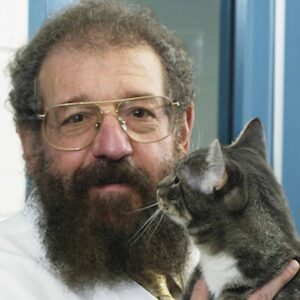Ron Hines DVM PhD

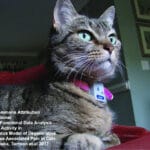
*************************
*************************
The healthy lifestyle you set for your cat doesn’t change with its age. It’s just that the bills for lifestyle choices don’t usually come due until later in your cat’s life. Many suggest that the due date is around 13 years of age. Many of the factors that influence how long your cat will likely live are under your control: Things like keeping it indoors and out of harm’s way. Indoor only cats tend to live considerably longer. Feeding it a quality commercial or, better yet, a home prepared diet. Keeping your cat trim and fit. Not neutering it at too young an age. Keeping your cat well hydrated and not giving it unnecessary vaccinations (not necessarily in that order). Your cat’s genetics undoubtably plays a part too. That is considerably more so in pedigreed cats than in the offspring of your neighborhood tomcat. The factors that affect your cat’s potential lifespan are many, highly complex and poorly understood. Some say that one year to your cat equals seven human years. Actually, a one-year-old cat is similar to a teenager of about 17 years of age. A two-year-old cat is physically equivalent to about a 24-year-old person. After that, cat years drop in relation to human years so that by 10 years of age, your cat will be somewhat equivalent to you when you are fifty. By the time a cat reaches fifteen, it is physiologically nearer in cat-years to a seventy-three-year-old person. My oldest feline patient was a twenty-three-year-old neutered male cat – equivalent to about a hundred and four-year-old man.
What Should I Feed My Elderly Cat?
From the time a kitten is weaned, it will thrive on a diet that is high in moisture (fresh made at home or canned), high in quality meat protein, higher in fat than you and I, or our dogs require, and balanced in essential minerals, vitamins and amino acids. That is no different than your cat’s wild progenitors required. Their diet was primarily rodents, eaten in their entirety. Small wild rodents are about 80% water and 62% protein, 28% fat and 10% ash on a dry weight basis. Pet food manufacturers and veterinary nutritionists today still rely on rather spotty (1985) National Research Council (NRC) experiments when formulating commercial diets for your cat. The motivation for funding those studies initially was the use of cats as experimental animals. None of those studies examined feline diets influence on a cat’s long-term health or longevity. The more recent (2006) NRC guidelines as to your cat’s nutritional needs were highly influenced by the AAFCO, the pet food manufacturing trade association.
All National brands of cat food are quite similar in their nutrient analysis. But they differ in their digestibility based on the quality of their ingredients and the quality of their premix vitamin content. Those vitamin premixes are primarily imported from Asian sources. Their quality is quite variable. By the time your cat consumes the canned or dry commercial cat food you purchase, the amount of each vitamin in the can or sac can be considerably less than what is printed on the label. (read here) Regarding what is written on the sac or can regarding protein content regarding its protein content. The percent protein on the package tells you almost nothing. Protein content is measured by the amount of protein nitrogen the sample contains. (read here) But those tests do not measure how much of that protein is digestible. For example, feather meal is high in protein (~87%), but practically indigestible in its natural state. When included in animal food, it is first subjected to intense heat and pressure to make it more digestible. Your cat food may not contain feather meal; however, the high temperatures used to produce canned cat food and kibble have other deleterious effects on its protein content. (read here)
Despite cat food corporation marketing strategies, your cat, like its wild forest ancestor in the photo, will not thrive on carbohydrates or plant-derived proteins. Plant products are in there to keep company profits high and please cat owners who mistakenly believe that cats are little people. I don’t recommend that you feed your cat, regardless of its age, the boutique, higher-cost, brands sold in pet shops, by groomers, veterinarians and on the Internet. The cottage industry entrepreneurs who make these products do not have the resources to do frequent enough quality control and analysis of their diets. Many are actually produced by contract facilities, with just the sack, label and promotional marketing left to the individuals marketing these cat foods. If a problem does occur, not enough pet owners use any particular one of these brands for the FDA to be alerted promptly. Products produced by small companies are also more likely to vary from batch to batch than those sold by larger food corporations. They also tend to sit on the store shelves longer and become stale. Frozen and fresh pre-mixed cat foods sold online and through outlets and supermarkets are also more prone to contamination with unhealthy bacteria.
Another marketing ploy are store aisles full of feline “life stage” diets. There is no underlying science to support their nutritional formulas, any more than there would be for special aisles of young, middle-aged or elderly people’s food.
When your cat reaches an advanced age and your veterinarian discovers evidence of early organ disease, there are dietary changes that do make sense and increase life span. Lower iodine diets for cats with hyperthyroidism, lower phosphorus, moderate protein diets for cats with kidney disease, diets to reduce obesity in diabetic cats, higher fiber diets for cats with constipation issues, etc.
Should I Feed My Aging Cat Canned Or Dry Cat Food?
For many years, veterinarians recommended dry cat chows for all of their feline patients. Vets and cat owners noticed that cats fed crunchy dry kibble tended to have cleaner teeth, less gum disease and less of a problem with obesity. Dry cat kibble also lacks can-liner chemicals that some associate with hyperthyroidism (bisphenol-A). Today, we are less certain if that is reason enough to recommend dry feline diets. Dry kibble is very convenient. It doesn’t smell like canned cat food does. It doesn’t spoil nearly as quickly as canned cat food once the can has been opened. Dry cat food is economical and, theoretically, meets all of your cat’s nutritional needs. However, it is a highly unnatural diet for your cat. Most formulas are much higher in carbohydrates (and some in plant-based proteins) than Nature intended cats to consume. As I mentioned, the primary reason for all that carbohydrate (aka starch) is increased company profits, although carbohydrates in dry cat food also help “cement” dry kibble pellets together during the baking process. Some veterinarians associate the high carbohydrate content of dry chows with susceptibility to diabetes. That has not been proven. After compression and baking, dry cat food is sprayed with fatty animal digest to make it more palatable and add a meaty aroma. In storage, that fat can become rancid and unhealthy. (read here) But the biggest potential problem is that cats eating dry diets almost never drink sufficient water to equal the hydration they would get consuming a canned or meat-based home-prepared diet. Some veterinarians associate this potential chronic dehydration with kidney or bladder disease (struvite/oxalate crystals). This is again unproven. My solution has been to prepare my cat’s diet at home from the same supermarket ingredients that you eat. (read here) Quality control for food intended for human consumption tends to be considerably better than for food destined for our pets. No factory is capable of turning out as healthy and tasty a meat-based product as you can in your own kitchen from the things that you yourself eat. When you do, you need to include a vitamin mineral supplement. The alternative to that is a small amount of powdered eggshell in your cat’s diet and a weekly serving of chicken liver. I suggest that whatever you prepare be lightly cooked.
Fish
Everyone knows that cats tend to prefer the taste and smell of pungent umami-rich fish-based cat foods. Two constituents that are quite high in tuna are thought to be responsible for that. (read here) But it has been my experience and that of other veterinarians that cats do not thrive on canned, fish-based cat food when it is fed in excess or exclusively. Perhaps that is due to the very low quality (stale and partially decomposed, unsaturated fatty acids and lipid peroxides) in the fish products that end up in the cat food ingredient chain – fish that sat too long on the dock. That beautiful tuna or salmon steak you see on the can or sac isn’t in there either. Even if not deteriorated by a lack of refrigeration, what gets routed to the cat food ingredient chain is primarily what was left of the fish after the two fillets had been removed, head, guts, fins and spine. If you must feed large portions of fish products to your cat frequently, I suggest that you give supplemental vitamin E antioxidant and thiamine as well to combat the toxicity of rancid fish oil and thiaminase. (read here & here)
If you begin getting your cat used to having its teeth brushed when it is young, it will allow you to brush its teeth for the rest of its life. That is particularly important if you plan on a diet of soft cat food, canned or fresh. Toothpastes with flavors acceptable to most cats are available. That should keep its teeth and gums healthy far into its older years. There are other options. (read here & here) You can also see if your cat will accept Greenies™/DentaLife™ and similar chewy products. They are basically glycerin and carbohydrates, so they should not make up a large part of your cat’s daily diet.
Most elderly cats develop a few gum issues as the years go by. Although few cats develop cavities like we do, many have lost the ring of gum tissue that surrounds and protects the bases of their teeth (gum recession, periodontal disease). That occurs most frequently at the base of their canine teeth and first molar tooth. With that protective layer gone, oral bacteria gain access to your cat’s tooth’s roots, which are composed of much softer dentin without an enamel coating. Oral blood circulation is important for oral health and jaw bone density too. That circulation tends to decrease with age as well. A separate problem is tooth resorption. Veterinarians do not know why that sometimes occurs. It tends to begin in midlife and has often progressed to complete tooth destruction in the cat’s old age.
I mentioned that cats consuming primarily soft diets will accumulate substantial tartar by the time they reach old age. This is much more than a case of simple hygiene and strong breath. Oral bacteria that live in your cat’s mouth have the potential of moving through the bloodstream and lodging in your cat’s kidneys and heart valves. While still confined to the mouth, they are a constant source of inflammation and discomfort. If your cat is losing weight, reluctant to eat, drooling or chewing gingerly, examine its teeth. Better yet, have your veterinarian have a look. All cats with advanced dental problems have a very strong and unpleasant breath. Periodically having your veterinarian’s nurse clean your cat’s teeth will slow the advancement of this problem. Since general anesthesia in elderly cats is never without risk, I usually suggest to my clients that all severely affected teeth be extracted rather than cleaned again and again and again. Cats do very well without many or any teeth. They seem perfectly happy and quite relieved after all these bad teeth are gone. So their appetite and weight often return to normal.
When you “brush” your cat’s teeth at home, use toothpaste designed for cats. I prefer a rubber fingertip applicator over a toothbrush because it allows you to better massage your pet’s gum line and reach the inner surfaces of the teeth and gums. Start getting your cat used to the procedure while it is still a kitten. To have significant benefit, home tooth care needs to start when your cat is young – before destructive changes have become severe.
.
Kidney and Urinary Tract Issues
Kidney disease, dental disease and cancer are the lead issues that older cats face. In a Davis study, by the time cats reached the age of 11, approximately 63% of them had microscopic evidence of kidney damage, although only half of that number went on to die from kidney failure. That is why I mentioned earlier that a very important advantage of canned or home prepared moist diets over dry cat chows is better hydration. No one has proven that the under consumption of water causes kidney damage in cats, But many studies associate dehydration with kidney stress. (read here, here & here) If you must feed your cat a dry diet, adding warm water to it before feeding is wise. However, if you do that, the possible increased dental issues need to be thought about too. Read some of your options on that here and here.
Would A Vitamin Or Other Supplement Help My Elderly Cat?
Cats that are eating nutritionally balanced cat foods really don’t need extra vitamins. The same goes for us humans, but that doesn’t stop 86% of us from taking them anyway. In most cases, they do no harm. The primary ones you need to never give in excess are vitamin D and vitamin A. Many older cats suffer from arthritis. The internet is full of glucosamine and chondroitin arthritis remedies for cats. No one has proven that they work or do not work in relieving feline arthritis pain and inflammation. The same goes for us humans, most large studies indicate that they are not harmful, but their benefits have not been proven, and they leave it to individuals to take them or not take them. (read here) If your elderly cat suffers from motility issues, give them a try and see if they are helpful. The most accurate way to decide is with an activity monitor.
Is My Old Cat Too Fat? – So What’s Wrong With A Chubby Cat?
I would guess that a chubby cat would be just as content as a cat of normal proportions. And certainly happier than a thin cat deprived of food. No one has explored if fat cats live longer than svelte cats, but with certainty, they are more likely to become diabetic. At least that has been my experience. Many believe that overweight cats are more prone to urinary tract blockages and chubby cats eventually reach the size that they no longer groom themselves adequately. It is often said that overweight elderly cats are more prone to arthritis, heart disease, liver and pancreatic problems. That may well be true, but I do not know of any studies that document it. You can read more about strategies to bring your cat’s weight down here. Cats that abruptly reduce their food intake are susceptible to hepatic lipidosis – a very serious problem.
Giving A Hand With Grooming
Your elderly cat might lack the energy and flexibility to keep itself well groomed without your help. It is particularly true in longer-haired cats, but mats along the spine, groin and armpits can be an issue in any oldster. Sometimes, the skin under those mats becomes quite inflamed. I prefer to remove mats with a matting comb, a soft slicker brush and very carefully used scissors when required. Groom your cat several times a week rather than letting the mats get large and out of hand is considerably better. I prefer that you not take your cat to grooming parlors or veterinarians for this service. It stresses out cats too much. You can have a trusted mobile van groomer visit your home and see how that goes. Long-haired cats can be sheared at home twice a year once you get the hang of it. Frequent brushing also helps cats from binding up (constipating) with swallowed hair. Be sure to check your pet’s claws as well. They overgrow when cats are inactive. Elderly cats rarely if ever require a complete immersion bath. You can almost always clean them sufficiently with a soft wash cloth, infant-safe soap and warm water. Flea baths are a waste of time and very stressful to cats. Your vet has plenty of topical and oral products to sell you that do a much better job.
Your Cat’s Creature Comforts
Making small modifications to your home and household routine can make life easier for your elderly cat. If they could, they would also tell you that they greatly appreciate a life free of disruptions, racket, and change. A soft bed, in a quiet, accessible location and a window ledge to bask in the sunshine will be much appreciated. Purchase appurtenances that don’t have high lips or ledges they must step over to gain access. Many old cats appreciate a source of added warmth on cold days. Either set your home thermostat a bit higher or purchase a low wattage heating bed liner that warms to approximately 100° F. But be sure your cat is ambulatory enough to move to a cooler corner spot if it so desires. Build or buy ramps to help your cat climb onto its favorite sofa or recliner. Keep food and water bowls within easy reach. Use shallow bowls with low sides and keep water bowls in multiple locations around the house. We do not want your cat to become dehydrated. You might even consider Hydra Care™. Warmed, canned cat foods with a pungent odor and a bit of added water also encourage picky eaters to stay well hydrated. New pets – especially new cats – invading their space is never appreciated. A gentle, house call veterinarian to avoid stressful trips to the animal hospital is always appreciated too. As is a pet sitter when you travel. Never board elderly cats. No matter what uplifting name given to a boarding cattery, how accommodating the smiling staff might be, or how pleasant the appearance, it will always be a flophouse in the eyes of your cat.
The warmth of an electric heating pad, used as a cat bed-liner, might also be comforting, as are good nail care, ramps, and litter boxes and food dishes with low sides. Some arthritic cats appreciate a gentle massage. As I mentioned earlier, be sure your cat is ambulatory enough to get off from any heat source once it finds it too hot or uncomfortable.
Loss Of Litter Box Training – Soiling In The House
It is a common problem in older cats that they are less tidy. The first thing to do is separate a behavioral issue from a health issue. Some cats loose litter box training because they are elderly and have motility issues. Others, because they feel stressed, perhaps by younger cats in the household, and still others because they have specific illnesses. These three causes occur in roughly equal numbers. When removing inter-cat stress, other stressors, and dietary and/or home modifications do not solve the problem; your veterinarian needs to become involved. Blood and urine tests will check if a urine problem is due to urinary tract disease and other tests can rule out digestive tract disturbances and metabolic problems such as diabetes or hyperthyroidism. Read more about litter box issues here.
What Health Problems Are Common In Older Cats?
As I mentioned earlier, your cat’s kidneys are quite sensitive to the passage of time. So failing kidneys are a very common health problem in older cats. Also high on the list are feline cancers. For reasons unknown, cancers in cats are often more aggressive than those veterinarians encounter in dogs. Health problems like these often make their appearance in cats between 9 and 11 years of age. By the age of 12 they become even more common. It is also common for oldsters to have more than one problem going on at a time. Hyperthyroidism and hypertension (high blood pressure) often appear at the doorstep together. When your veterinarian runs blood tests on your elderly cat, the results will almost never be quite the same as they were when it was younger. Unfortunately, many test “normal ranges” are not adjusted for age, and no medication we veterinarians possess will turn back the clock. In many cats, whether or not it has persistent high blood pressure cannot be determined accurately at veterinary hospitals. (read here) Before you agree to place your cat on a blood pressure lowering medication such as amlodipine, you really ought to have a house call veterinarian confirm high blood pressure is occurring in your cat while it is at home. Even then, your cat needs to be relaxed, and several sufficiently spaced readings need to be taken.
The Dangers Of Being Too Thin
As cats approach 14 – 18, they often have a harder time maintaining their traditional body weight. Sometimes that is due to the dental issues I mentioned earlier. But other times, your veterinarian can find no cause(s) other than the general upward creep of laboratory blood values associated with time. Cats that become abnormally thin and frail are at greater risk of dying, just as we are. (read here) It is very advisable to have your cat’s T4 (thyroid hormone) level determined every year. Weight loss is one of the most common symptoms of hyperthyroidism that cat owners are likely to notice. When it comes to prescription diets, diet changes and medications, it is extremely important that an underweight cat not increase it rate of weight loss due to a new diet or medication. Maintenance of body weight and, hopefully, increase in the weight of underweight cats trumps everything else. Your fussy cat will be much better off eating whatever it is that it prefers rather than products it will not eat. Sometimes, all it will take is a topping of a savory broth. Sometimes that is insufficient. Some believe that with time, your cat’s sense of taste and smell become less acute, making it more likely to reject bland diets. That occurs in humans as well. (read here & here) Not confirmed in cats, but plausible, is that elderly cats might be less able to absorb the nutrients present in their diets. (read here)
Selecting a canned or home-prepared, cooked, meat-based diet that is high in calories could be helpful in maintaining or increasing your cat’s body weight. Although cats that have been eating dry-chow for most of their lives may resist that change. As I mentioned, a pungent aroma topping can be critical to success. Warming your elderly cat’s food to its body temperature will also make it more appealing. Feed your oldster small amounts, but more frequently. Some cats prefer your presence and petting while they munch, others do not. Off their food in shallower bowls. Weight loss problems in elderly indoor cats are rarely due to intestinal parasites (that might be less the case if you are feeding a raw uncooked diet). So repeated worming medications are not likely to be helpful. Don’t give in to feeding primarily tuna, potted meats, table scraps or baby foods because you will just exchange one problem for another. They are fine as toppings, but not as a major portion of your cat’s diet. As I mentioned earlier, I would avoid canned a dry fish-based cat foods entirely because of the low quality of the fish ingredients they contain.
Eye Changes And Cataracts
What most cat owners believe are cataracts in their elderly cats are actually a change called lenticular or nuclear sclerosis of their lenses. When it is just a moderate haze, it does not appear to affect your cat’s vision. Another common change is a more lacy appearance to the colored portion of your cat’s irisesas time goes by. Cats with hypertension often have irreversible changes in the rear interior lining of their eyes (their retinas) that do effect, or prevent vision. Read more about those age related changes in your cat’s eyes here. It is conceivable that your cat’s vision will be affected by the wavelengths of the light it is exposed to in your home. Light in the ~600–700nm range might penetrate your cat’s corneas and reach its retinas more effectively than ordinary incandescent bulbs. That seems to be the case with humans. With the new, energy-saving lighting systems on the market, I cannot tell you which, if any, might improve its vision.
Constipation
Intestinal motility decreases in the elderly, making one prone to constipation. It is no different in your cat. But in cats, dehydration will further complicate this potential problem, as will arthritis. Cats with long hair coats and a failure to groom sufficiently before hair clumps form and are ingested will also become “bound up”. This problem can usually be managed by having a traveling pet groomer clip your long-haired cat. Be sure their clipper blades are fully cleaned and disinfected after every use. Increasing the amount of fiber in your cat’s diet and the amount of water it consumes can be beneficial as well. The fiber in most commercial diets sold to combat feline constipation is sugar beet pulp. Never feed it dry because beet pulp swells when exposed to water. When that is not enough, periodically giving your cat a hair-ball remedy containing petrolatum is another option. They are sold in toothpaste-like tubes in a malt or fish-flavored form. Mineral oil should never be given to cats because they are likely to inhale some of it. Both interfere with the absorption of the fat soluble vitamins in your cat’s diet. (read here) Others administer a small amount of lactulose. That can be associated with flatulence. It is more common to give lactulose to cats because they have developed advanced kidney disease. In that case, it is given to combat uremia. Lactulose must be used cautiously in diabetic cats. Never give your cat phosphate-containing enemas such as Fleet™. If the problem is occasional and mild, you can try adding a teaspoon full of soaked rice bran or psyllium seed powder to your cat’s diet. One to 2 teaspoons full of unsweetened canned pumpkin is another alternative. If your cat is bloated and uncomfortable or cannot pass its stools, it is time to visit your vet.
Personality And Behavior Changes
Veterinarians really have no way to determine if personality and behavioral changes in your older cat are due to deterioration of its mental abilities (cognitive dysfunction) or are secondary to organ dysfunction, or a little bit of both. The most frequently reported behavioral problems in older cats are said to be their loss of litter box training and restlessness or meowing loudly at night. The best we can do is dispense medications to treat impending organ failure we detect in our examinations and testing procedures and see if the situation improves. Those include arthritis, chronic kidney disease, hyperthyroidism, triad disease, deafness and, perhaps, even a brain inflammation or tumor. If those treatments do not help, we are left with medications such as Selegiline/L-deprenyl. Selegiline is marketed for dogs by Zoetis under the trade name Anipryl® for loss of mental abilities and other purposes. In severe cases, cat owners commonly describe their cat’s situation as being dazed, confused, disorientated, forgetful of past learning and pleasures, trapped in corners, spacey, aimless wandering, less playful or more irritable. In those cases, your cat also needs to be checked for hepatic encephalopathy secondary to liver failure. Abnormally high blood ammonia levels that often accompany liver failure can be responsible for that.
Many elderly cats have changes in their sleep-wake cycles. It is common for them to be up more at night, yowling, pacing, and aimless wandering or restless, but a few withdraw into themselves, playing less and sleeping more. Sometimes you can make schedule changes to minimize the problem. Things like confining the cat to other areas of the house, playing soft music or keeping the cat awake and active until you go to bed. Keeping food, water and litter box conveniently available to the cat might also help.
Dealing With Arthritis Pain
Cats do not show joint pain the way children or dogs do. They disguise it well. Cats are not complainers when it comes to arthritis-related joint pain. If at all, your cat might express chronic pain in subtle ways. It might walk with a shortened, mincing or tippy-toed gait. The range of motion of its joints might be somewhat decreased. Your cat might meow or nip at you if you manually over-flex or over-extend its legs. They rarely have visible joint enlargements, joint swelling or increased joint heat. X-rays rarely show significant hip, elbow, shoulder or spinal arthritic changes. Those few radiographs you find on the internet generally represent cats with joint issues due to their genetic inbreeding, as in Scottish fold. Or they are the one-side-only results of a long-ago trauma. As I mentioned, lameness is rare. So vets and cat owners alike are reduced to subtle hints: reluctant to jump onto your sofa or to climb your stairs. Difficulty getting in and out of their litter boxes. Preferring to defecate next to their box instead of in it. Or, you might just observe that your pet doesn’t play as much as it once did. It might be more irritable with you or other pets attempt to.
Unfortunately, cats do not tolerate repeated effective-size doses of the common NSAID pain medications as well as most dogs and humans do and Tylenol®/acetaminophen is toxic to cats. In all other domestics species and humans, NSAIDs (Non-steroidal anti-inflammatory drugs like Rimadyl®/carprofen or meloxicam) are the first line choice for the relief of arthritis pain. But cats do not metabolize or react to these drugs as well as dogs and humans do. So they are dangerous to give to your cat for prolonged periods, at least at the doses and frequencies at which they are effective. When you decide that the benefits of a pain-free (and possibly shorter) life outweigh things as they are now, those medications might have a place in your cat’s treatment. But cats on long-term NSAID’s need to be monitored closely for toxic side effects (hidden bleeding into the digestive system, anemia, kidney and liver toxicity, intestinal perforations, etc.) In 2023, a new option because available, Solensia®. You can read about Solensia here. However, this drug marks a new entry into uncharted waters. I suggest you read cat owner feedback on the use of Solensia® here. However, as you read those cat owner’s experiences, please realize that people are more likely to write to me when they have experienced a problem than they are when all went well.
Narcotics, such as fentanyl, patches control pain well in older cats. But veterinarians are too intimidated by the DEA to prescribe them for any length of time. Besides, all opiate narcotics encourage constipation. The most commonly used non-prescription product that claims to reduce arthritic pain is a glucosamine and chondroitin nutritional supplement. Many owners of older, arthritic cats are pleased with the performance of these products and there is certainly no harm in giving them to your cat in reasonable doses.
Another option are injections of Adequan (polysulfated glycosaminoglycan). They are an option if oral glucosamine/chondroitin is not effective. The company hypes this products shamelessly, but perhaps it might help your pet. It is not approved by the FDA for use in cats, but you can discuss its use with your veterinarian. Some might agree to administer it, some might not. Since both glucosamine/chondroitin and Adequan are usually given as part of a multi-faceted pain control program, it is hard to judge their true effectiveness. Weight control and often weight loss is important when your arthritic cat is overweight. (read here) There might come a time when steroids, such as prednisolone, are legitimate alternatives for a cat in constant discomfort. Cats can tolerate these medications for quite some time when the dose is cautious, intermittent, and your cat is closely monitored for the side effects all steroids produce.
Cancer
The frequency of cancers increases with age in everyone, our cats included. And almost every treatment that is available to us humans is available, somewhere, for your cat. The question I cannot answer is, if your cat would want to undergo some of these treatments if it could discuss the matter with you first. You know your cat best, and you are the one who can best make that decision – not your veterinarian or some specialist. There are endless variations of cancer. And they can appear anywhere in your cat’s body. For a tumor to be named and identified, a portion of it (a biopsy) must be sent to a pathologist. That is the only way a valid treatment plan can be put together. Some of the symptoms that might lead you and your veterinarian to suspect cancer in your elderly cat are lumps, bumps and unhealed sores anywhere on its body, weight loss, loss of appetite, difficulty eating or swallowing, chronic diarrhea or vomission, bleeding or discharges, persistent lameness, difficulty breathing, urinating or defecating. Read more about cancer in older cats here.
Will More Frequently Visits To My Veterinarian Make My Cat Live Longer?
There are certain diseases of cats that have early warning signs that your veterinarian can detect before you do. Some have cures and some don’t. That is why an annual blood test (geriatric or wellness blood & urine profile), dental exam, and physical exam might extend your pet’s life – just as it might extend yours. If you yourself detect changes in your cat’s body weight, activity level or any other bodily function, bring your cat in, regardless of the date of its last exam. The American Association of Feline Practitioners recommends a veterinary visit for elderly cats every 6 months. That is a bit extreme, unless a progressive disease is already known to exist, although it is true that the earlier certain diseases are detected, the more options you might have to treat them. A problem to me is the current tendency for veterinarians to “upsell” services. That is often left to the receptionist or veterinary nurse. Resist the temptation to leave with a basket full of products you had not intended to purchase. Prescription foods, cannabis products, glucosamine/chondroitin products, vaccine boosters, laser treatments, alternative medicine, and vitamins lead that list. Elderly, indoor cats, other than those in shelters, in-and-out group homes or other extraordinary situations, have passed the point in their lives when vaccinations are likely to be of benefit to them.
End Of Life Issues
Extremely few cats like the Garfield above live to be 23 years old. That is ~108 in human years. I once wrote an article on dealing with terminally ill pets and the grief that will most certainly cause you. You can read it here. The late Dr. Bernard Rollin, of the Department of Philosophy and Veterinary School of Colorado State University, who was a friend of mine, wrote an article for veterinarians on this subject. He cautioned against the cruelty of artificially keeping a suffering animal alive too long – something he believed pet owners and veterinarians too often do. You can read his article if you ask me for Rollin2007.
You are on the Vetspace animal health website
Visiting the products that you see displayed on this website help pay the cost of keeping these articles on the Internet.

